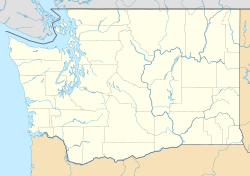This article needs to be updated. The reason given is: Name and status of property may have changed recently, but reliable sources are needed.. (May 2024) |
Hoquiam's Castle, also known as the Robert Lytle Mansion, is a private residence in Hoquiam, Washington. Built in 1897 and completed in 1900, it was added to the National Register of Historic Places in 1973.[2]
Hoquiam's Castle | |
 Hoquiam's Castle | |
| Location | 515 Chenault Ave., Hoquiam, Washington |
|---|---|
| Coordinates | 46°59′04″N 123°53′16″W / 46.98444°N 123.88778°W |
| Area | less than one acre |
| Built | 1897-1900 |
| Architectural style | Richardsonian Romanesque |
| NRHP reference No. | 73001868[1] |
| Added to NRHP | April 11, 1973 |
Description
editHoquiam's Castle is a wood-frame structure on a hand-fitted sandstone foundation[2] situated on a hillside.[3] Primarily Richardsonian Romanesque style, the exterior includes Queen Anne and Shingle elements.[4] The structure consists of a full basement, three floors, and an unfinished fourth floor.[2]
The entrance to the 10,000 square feet (930 m2)[5] house is fronted by 12 feet (3.7 m) wide sandstone stairs with a sandstone arch and cement lions at the top. The sandstone for the foundation and stairs was quarried in Tenino, Washington. On the southwest corner is a tower projecting from the third floor. The house has over 20 rooms. Interior woodwork on the first floor is golden oak. The main salon is illuminated by a 600 piece crystal chandelier. Both the music room and dining room have 9 by 5 feet (2.7 m × 1.5 m) pocket doors. The third floor has a ballroom with a 20 by 60 feet (6.1 m × 18.3 m) bandstand.[2] A bathroom on the second floor contains a porcelain commode made by Thomas Crapper.[5]
The mansion was the first home in Hoquiam to have electric lights.[2]
History
editThe Lytle brothers, Robert and Joseph, ran a grocery business in Fairhaven, Washington, then moved their business to Hoquiam.[2] In the 1880s, Hoquiam became a center for lumber.[4] When a customer paid his bill by turning over his logging operation, the brothers became part of the logging industry.[2]
Robert F. Lytle began building his house in 1897, next door to his brother's house. Robert's house which became known as Hoquiam's Castle was completed in 1900.[5]
Shortly after the house was completed, Lytle gave it to his niece, Theadosia Bale, as a wedding gift. After Bale died in the 1950s, the house was unoccupied until 1968.[5] In the early 1970s, the Robert Watson family restored Hoquiam's Castle.[4] For some years, it was operated as Hoquiam's Castle Bed and Breakfast.[6][7] When it was sold in 2004, the new owner allowed it to be set up as a "haunted house" to raise money for children's activities.[8]
References
edit- ^ "National Register Information System". National Register of Historic Places. National Park Service. November 2, 2013.
- ^ a b c d e f g Robert Edmond Watson (Dec 21, 1972). National Register of Historic Places Inventory/Nomination: Hoquiam's Castle. National Park Service. Retrieved August 27, 2019. With accompanying pictures
- ^ Nestor, Sandy (2001). Our Native American Legacy: Northwest Towns with Indian Names. Caxton Press. p. 32. ISBN 978-0870044014.
- ^ a b c Naversen, Kenneth (1987). West Coast Victorians. Beautiful America Publishing. p. 224. ISBN 0898024951.
- ^ a b c d Barger, Richelle (May 29, 2015). "Queen of Her Castle". Washington Coast Magazine. Retrieved 27 August 2019.
- ^ Larsen, Jeff (Dec 12, 2002). "Logging's Glory Days Live on in Mansions". Seattle Post-Intelligencer. Retrieved 27 August 2019.
- ^ Rhodes, Elizabeth (Aug 22, 2002). "Pampered guests can have a ball in historic bed & breakfast". Seattle Times. Retrieved 27 August 2019.
- ^ Hong, Kevin (Oct 20, 2005). "Hoquiam's Haunted Castle opens tonight". Daily World (Aberdeen, WA).

